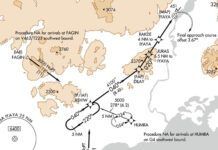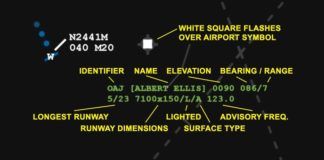Like many of us, my insurance requires periodic formal recurrent training. Although choices are limited, I’ve tried to explore new (to me) facilities and to review that facility in these pages. This year I attended Cessna 340A Recurrent Training at National Flight Simulator in Manchester, NH. It was a positive experience and I’m glad I went.
Who?
Although they advertise, National Flight Simulator is one of those facilities that few of us know. It was started in 2006 in Nashua , New Hampshire by Steve Cunningham. Initially, his company was little more than Steve’s simulator in a corner of his hangar. But, Steve’s passion for aviation and for excellence in training led the company to expand to it’s current location at Manchester Airport, KMHT, in the former terminal building that was retired and turned into offices.
Here, National Flight Simulator has three AATD simulators and one BATD sim along with some backups. They say this about their pool of instructors: “Our instructors are seasoned aviators, with extensive teaching experience. Because each aircraft is unique, we ensure our
instructors have significant hands-on flying time in the particular make and model they teach.” Although most training facilities make this claim, my experience has been that it’s not always true. However, the instructors I encountered at National Flight Simulator were well qualified in the aircraft they taught.
They offer a wide range of programs, from simple instrument refreshers and rusty-pilot exercise, to full refresher training on everything from basic piston singles, to piston and turboprop cabin-class twins. Their regular customers include a number of government and military agencies from some of our neighbor countries to the south.
Note that the facility is located at KMHT—a regional airport offering some airline service and a lot of business aviation. If large airports with large prices aren’t to your liking, there are numerous smaller airports within 10–40 NM.
The Facility
None of the training facilities I’ve visited for piston-twin training offer the luxury and posh environment provided by the big names like CAE or Flight Safety, although SIMCOM is probably the best of the rest.
The facility at National Flight Simulator is best described as basic. As noted, the building is older and has been converted to offices. However, it appears to be in good repair and the offices of National Flight Simulator were clean and sufficient for the tasks.
This was fine with me; I put economy and quality training far ahead of a posh environment, so long as the environment is sufficient. Theirs is.
While the physical facility might not be top-tier, National Flight Simulator strives to provide what they call a “concierge-level experience.” This includes offering a courtesy car, nocharge aircraft parking at their facility, assistance with local arrangements, etc. I found the staff to be professional, but friendly, easy going, and quite accommodating. If you’re flying commercially into MHT, they’ll even pick you up from the terminal.
The cost of this course is $2360, making it one of the least expensive offerings available. A second attendee to the same course at the same time is half price, $1180. Volume and organizational discounts are offered.
The Training
The course outline specifies 10 hours in the sim and 10 hours in the classroom. We needed neither to cover the material. Although I wasn’t keeping a stopwatch on the training, I’d estimate we spent about eight or nine hours on systems and perhaps six hours in the sim. The pace was quite relaxed as we went through the requisite material using all the time needed to cover it. In fact, I completely bollixed one sim exercise and we repeated it a couple times until I bollixed it less. For me, the 2½-day curriculum was completed in two days, which apparently is so typical that they usually just schedule it for two days.
Mr. Bob DiMeo was my instructor. We hit it off right away. Bob started off in the computer industry and after numerous successes there, was able to blend that experience with his love of aviation by getting a job flying and managing a Cessna 340A test platform for a specialty instrument and avionics company.
DiMeo’s 340-specific experience was quite refreshing and beneficial. As we’d go through a topic, invariably one or the other of us explained some personal experience related to that particular system; we both learned a lot from that interchange. Yes, he had the instructional material and led the discussions, but the systems review was more of a give and take that was far more useful than what I call “death by PowerPoint.” This felt like more of a focused and targeted hangar flying session than actual instruction. It was quite refreshing and informative—a great way to learn.
Instructional Material
I’ve been to Cessna 340A recurrent training at multiple facilities, including SIMCOM. SIMCOM develops their own training material, and it’s widely and openly used at some other facilities. While Bob had a SIMCOM manual at hand as a reference, our review used material developed in house. It was nice to see that what presented as a personal, one-on-one training experience originated with the extensive professional effort and research needed to assemble material sufficient for a full aircraft systems briefing covering up to 10 hours.
Training material such as this often contains errors. I don’t recall seeing any, although a couple of the illustrations did have hand-drawn additions for clarity. The material was useful and accurate.
The Simulator
National Flight Simulator primarily uses Elite iGate AATD simulators. It has been a persistent complaint of mine that no commercial ATD simulator manufacturer of which I’m aware makes a Cessna 340-specific simulator. All the sims I’ve found that are affordable for a training business (under a couple hundred thousand) are generic twins or mimic something like a Baron.
The Elite iGate in use for Twin Cessna training at National Flight Simulator had a generic six-pack panel layout and mimicked a Baron 58. Thus, there were no circuit breakers, no pressurization system controls, no emergency gear handle, etc. Since nobody makes a Cessna 340 AATD, the choice is to substitute as they’ve done, or spend another few hundred thousand on custom sims.

They have scripted line-oriented flight training (LOFT or scenario training) that involves some planning and execution of a full flight. You can expect failures from minor to more serious. The idea, of course, is that this better emulates the types of missions you’ll actually fly. Not all the instructors use these, and DiMeo opted not to.
My time in the sim was concentrated more on instrument currency (I was still legally current and somewhat proficient.) with approach after approach, and general malfunctions like engine failures. While this was beneficial, and as much as I understand and accept the compromises that enable lower prices, I’d have liked to explore some edges of the envelope that would be possible if the sim represented a Cessna 340.
For this reason, I’d label this training not as an overall Cessna 340A Recurrent Training, but as a multi-engine instrument refresher tied to a Cessna 340A systems review. (Don’t tell my insurance company.) Is that a bad thing? Probably not, but it could be a better thing. Since the actual simulators have a limited range of simulated aircraft, I’d expect that most training they offer is similar, with aircraft-specific systems and general sim work.
However, if you want time in your actual airplane to work out some items not covered in the sim, dual is available in your aircraft. Clearly, this could make up for some of the shortcomings of the sim and might be the best of both worlds.
Bottom Line
As I noted in my November 2018 article about SIMCOM, probably the best measure of the quality of a training center is if you’d willingly return. I can definitely say that I look forward to another opportunity to train at National Flight Simulator.
In fact, as I was saying my goodbyes to the staff upon my completion, I was already thinking of ways I might return.
I’ve reviewed SIMCOM twice and Recurrent Training Center (RTC) once. RTC is now under different ownership and management at a new location, so I should return to see how their new facility in Tampa measures up.
Similarly, National Flight Simulator owner Steve Cunningham is seriously considering that it’s time to retire and is exploring opportunities to sell the business. Assuming he does sell, it would be worth a return to see how the inevitable changes implemented by new owners have impacted the overall student experience. I look forward to that opportunity





